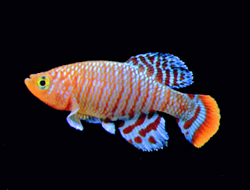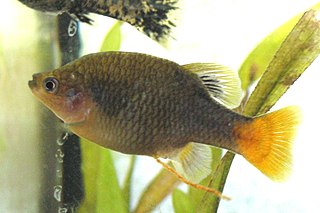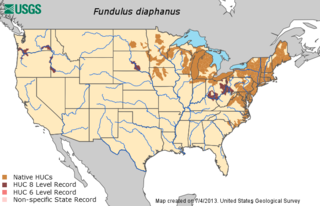
Cyprinodontiformes is an order of ray-finned fish, comprising mostly small, freshwater fish. Many popular aquarium fish, such as killifish and live-bearers, are included. They are closely related to the Atheriniformes and are occasionally included with them. A colloquial term for the order as a whole is toothcarps, though they are not actually close relatives of the true carps – the latter belong to the superorder Ostariophysi, while the toothcarps are Acanthopterygii.

The mummichog is a small killifish found along the Atlantic coast of the United States and Canada. Also known as Atlantic killifish, mummies, gudgeons, and mud minnows, these fish inhabit brackish and coastal waters including estuaries and salt marshes. The species is noted for its hardiness and ability to tolerate highly variable salinity, temperature fluctuations from 6 to 35 °C, very low oxygen levels, and heavily polluted ecosystems. As a result, the mummichog is a popular research subject in embryological, physiological, and toxicological studies. It is also the first fish ever sent to space, aboard Skylab in 1973.

A killifish is any of various oviparous (egg-laying) cyprinodontiform fish, including families Aplocheilidae, Cyprinodontidae, Fundulidae, Nothobranchiidae, Profundulidae and Valenciidae. All together, there are 1,270 species of killifish, the biggest family being Rivulidae, containing more than 320 species. As an adaptation to living in ephemeral waters, the eggs of most killifish can survive periods of partial dehydration. Many of the species rely on such a diapause, since the eggs would not survive more than a few weeks if entirely submerged in water. The adults of some species, such as Kryptolebias marmoratus, can additionally survive out of the water for several weeks. Most killies are small fish, from 2.5 to 5 centimetres, with the largest species growing to just under 15 centimetres (6 in).

Anoplopomatidae, the sablefishes, are a small family of ray-finned fishes classified within the order Scorpaeniformes. This family is the only family in the monotypic superfamily Anoplopomatoidea. These fishes are found in the North Pacific Ocean.

Goodeidae is a family of teleost fish endemic to Mexico and some areas of the United States. Many species are known as splitfins. This family contains about 50 species within 18 genera. The family is named after ichthyologist George Brown Goode (1851-1896).

Sander is a genus of predatory ray-finned fish in the family Percidae, which also includes the perches, ruffes, and darters. They are also known as "pike-perch" because of their resemblance to fish in the unrelated Esocidae (pike) family. They are the only genus in the monotypic tribe Luciopercini, which is one of two tribes in the subfamily Luciopercinae.

Fundulus is a genus of ray-finned fishes in the superfamily Funduloidea, family Fundulidae. It belongs to the order of toothcarps (Cyprinodontiformes), and therein the large suborder Cyprinodontoidei. Most of its closest living relatives are egg-laying, with the notable exception of the splitfin livebearers (Goodeidae).

The Rivulidae are a family of killifishes in the order Cyprinodontiformes. They are commonly known as rivulids, South American killifish or New World killifish. The latter names are slightly misleading, however, as they are neither restricted to South America, though most are in fact found there, nor are they the only killifishes from the Americas. Occasionally, they are still referred to as rivulines, a term dating back to when they were considered a subfamily of the Aplocheilidae.

The sheepshead minnow, also known as sheepshead pupfish, is a species of ray-finned fish in the family Cyprinodontidae, the pupfishes. It is found in salt marsh and estuary environments and is native to the eastern coasts of North and Central America.

The banded killifish is a North American species of temperate freshwater killifish belonging to the genus Fundulus of the family Fundulidae. Its natural geographic range extends from Newfoundland to South Carolina, and west to Minnesota, including the Great Lakes drainages. This species is the only freshwater killifish found in the northeastern United States. While it is primarily a freshwater species, it can occasionally be found in brackish water.

Goodeinae is a subfamily of splitfins from Mexico, part of the family Goodeidae. They are small fish which mostly live in fresh water, especially around Mesa Central, west of Mexico City. Members of the subfamily are also found in brackish water on both the east and west coasts. They typically have small ranges and many are seriously threatened. The subfamily takes its name from its type genus Goodea and so is ultimately named after the American ichthyologist George Brown Goode (1851-1896).

The Starhead topminnow is a native United States species that ranges from the Ouachita River drainage in Louisiana, the Big Black river in Mississippi, and extends northward into the Mississippi River and Lake Michigan basins to the southern Michigan and southern Wisconsin areas. The Starhead topminnow is endangered due to the removal of aquatic vegetation and the continued development of land that infringes on its habitat.
The blackspotted topminnow, Fundulus olivaceus, is a species of fish in the family Fundulidae: the topminnows and North American killifishes. It is native to the south-central United States, where it is known from the drainages of the Mississippi River from Illinois to the Gulf of Mexico and as far west as Galveston Bay.

The southern studfish is a ray-finned fish of the family Fundulidae, the tooth carps, that is native to the southeastern United States.
The diamond killifish is a species of North American killifish found in salt marshes, hypersaline flats and mangrove along the Gulf Coast of the United States. This species grows to a length of 6 cm (2.4 in). It is found in the aquarium trade. It was previously recognized as, Adinia xenica, the only known member of the genus Adinia. Nucleotide analyses has reevaluated the phylogeny of the Funduliidae and placed the diamond killifish into the Fundulus genus.
The Baja California killifish is a killifish in the family Fundulidae. It is native to the Baja California Peninsula region of northwestern Mexico. This fish was described by L.L. Vaillant in 1894 with the type locality given as San Ignacio de Caracamande in central Baja California.

The Gulf killifish is one of the largest members of the genus Fundulus; it is capable of growing up to 7 inches (18 cm) in length, whereas the majority of other Fundulus reach a maximum length of 4 inches (10 cm). Therefore, F. grandis is among the largest minnows preyed upon by many sport fish, such as flounder, speckled trout, and red drum. Fundulus derives from the Latin meaning "bottom," and grandis means "large". The Gulf killifish is native to the Gulf of Mexico from Texas to Florida and the eastern coast of Florida and the Caribbean Sea in the Atlantic Ocean. Threats to the survival of the Gulf killifish include extreme changes in salinity, changes in temperatures, and toxic events such as the hypoxic dead zone in Louisiana and the Deepwater Horizon oil spill. The Gulf killifish is currently being used to test the effects of oil and oil dispersants on the physiology of marine species affected by these substances. This is significant to conservation biology, because with the continued extraction of oil and other natural resources from North American waters, it has become increasingly important to understand the risks and consequences in worst-case scenarios, such as the Deepwater Horizon oil spill, and the lasting effects on the marine ecosystem.

The bayou killifish or bayou topminnow is a topminnow-like fish that thrives primarily in the shallow waters off the shores of the Americas, as well as fresh and brackish waters. Feeding off of small vertebrates and invertebrates, this fish displays reproduction techniques unique to its species.

Fundulus luciae, the spotfin killifish, is a member of the genus Fundulus. This hardy fish is notable for spending its entire life in sporadically flooded salt marsh habitat, sheltering in shallow pools, puddles, and small tidal rivulets. It closely resembles the mummichog in shape and coloration, but the two species can be distinguished by dorsal fin ray count: 8–9 in the spotfin versus 11–12 in the mummichog. Additionally, the dorsal fin of F. luciae originates farther back, and slightly behind the anal fin origin; in the mummichog, the dorsal fin begins anteriorly to the anal fin origin. The spotfin killifish is named for the pronounced ocellus found on the posterior dorsal fin of adult males. It is a small fish, seldom attaining 50 millimetres (2.0 in) in total length. Its distribution extends along the U.S. east coast from Massachusetts to Georgia.

Aplocheiloidei is a suborder of the order Cyprinodontiformes consisting of three families which are commonly known as killifishes.
















